Why You Should Wear Your Retainer
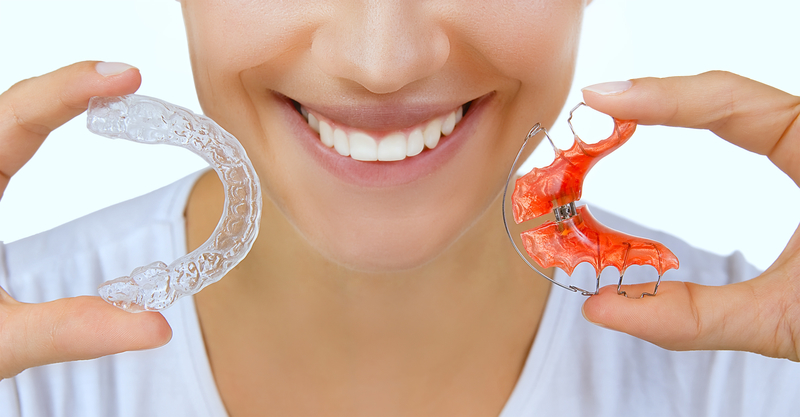
After you have your braces removed, most patients receive a retainer that they wear at night to keep their teeth from moving. But what kind of retainer should you have, and how long should you wear it? Retainers maintain oral health after braces by keeping your teeth in the correct alignment. Many people fail to use their retainers properly, and have to be fitted for braces again. Learn how to prevent your teeth from moving after braces and how to keep your teeth straight!
Purpose of Retainers
After you complete your time with braces, it will be necessary for you to consistently wear the retainer that your orthodontist advises you to wear. A retainer is an apparatus made of plastic and metal that is custom-made for each patient’s teeth and mouth. No two retainers are alike, but they all serve the same function as they seek to keep our teeth aligned properly after our braces are removed. Most people have to wear a retainer after they get their braces off, but many times people wear retainers to close gaps in their teeth, help with a speech impediment, or address specific medical issues. Retainers are especially important after your braces are removed, though, because our teeth will attempt to return to their original position after treatment. Another type of tooth movement that we want to avoid is natural physiological drift, which happens as the width of our smiles gets narrower as we age and our teeth begin to crowd. This occurs to everyone, but consistently using a retainer can prevent this shift in our teeth.
Getting your braces removed is definitely an exciting moment, but keeping your teeth straight is a lifetime effort. Our newly-aligned teeth need time to settle into our soft tissue and jawbone, and wearing your retainer helps this process be successful. Wearing your retainer at night and in between meals allows your teeth to hold their new form and prevents them from shifting back into their old position. As our bodies grow, our teeth follow suit, and retainers maintain the new tooth position that your braces achieved during your treatment. At the beginning, it may be necessary to wear your retainer all day for a few months, or you may only have to wear it at night a few times a week. Your orthodontist will advise you on how long and how often you should wear your retainer, and it is important that you follow all recommendations that you are given.
Types of Retainers
There are two main types of retainers that are used: removable and fixed. Removable retainers can be removed whenever you eat and brush your teeth, but typically must be worn full-time for at least one year after you get your braces removed. Hawley retainers are the most common type of removable retainer and is fit to your mouth shape with wires that wrap around your teeth. Invisible, or Essix, retainers are made of clear plastic that makes it look as if you’re not wearing anything, which increases its aesthetic appeal. Depending on the treatment plan you received during your time wearing braces, your orthodontist may recommend only wearing either of these two removable retainers at night. On the other hand, fixed retainers are those that are cemented to the backs of your teeth and kept in place for several years, even decades. This type of retainer is useful for those people who don’t want to worry about constantly removing their retainer or whose teeth have a higher likelihood of post-braces movement.
Caring For Your Retainer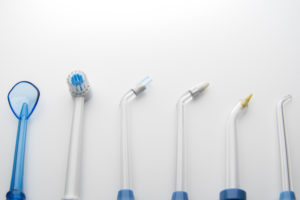
Depending on which type of retainer you use, there are certain instructions that are recommended to properly care for your retainer. For fixed retainers, regular dental checkups are essential to monitor for cavities and clean out any tartar or plaque. When flossing, make sure to use a floss threader that will allow you to go underneath the wire and clean between the teeth. As an additional measure, use a waterpik to rinse out food around the wire. Waterpiks should not replace normal flossing because floss physically removes bacteria from the teeth and gums while a waterpik merely rinses those areas. Although fixed retainers are incredibly strong, they can still break. Try to avoid biting hard foods, like carrots and nuts, with your front teeth to avoid any damage to your retainer. For a removable retainer, make sure to scrub it with soap and a toothbrush daily, or you can try soaking them in denture cleaning tablets or vinegar and water. Whenever you take out your removable retainer, make sure to keep it in a reliable case where it can be protected from pesky pets or avoid being accidentally thrown away. Don’t wear your retainer while playing sports, especially swimming, skiing, or contact sports, and make sure to avoid heat by keeping them away from hot water or hot car dashboards.
Tips For Maintaining Your Oral Health
Retainers play a vital role in keeping our teeth straight and preventing oral health problems, such as teeth crowding, but they aren’t the only recommendation for maintaining good oral health. Make sure to continue flossing and brushing your teeth daily, while visiting with your dentist every six months for a general checkup. For more information on the different types of retainers that are available and what would be the best fit for you, call Belmar Orthodontics at (303) 225-9016 to learn how to improve your smile and oral health!
Dental Emergencies With Braces
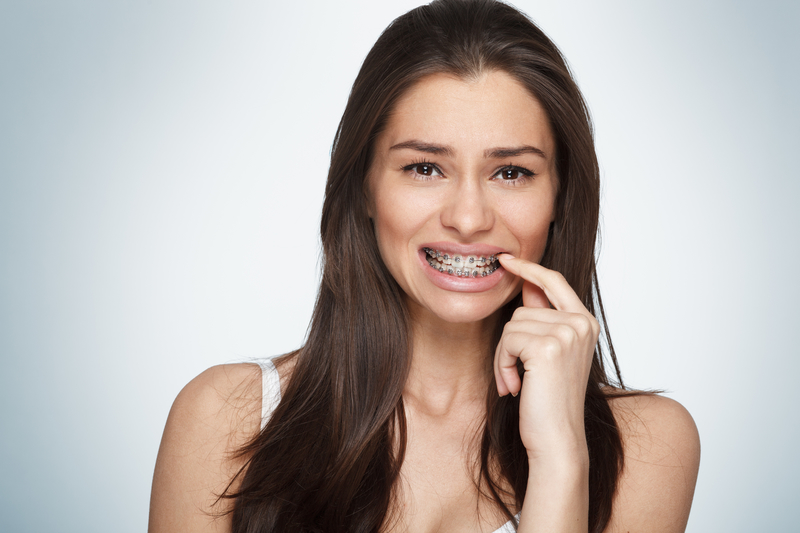
Braces are incredible devices that can help transform your teeth and reshape your jaws. However, they are not always fool-proof. Every so often, a patient will have a dental emergency. That may be a bad cavity that needs to be fixed, or a bracket or wire will break. There are only a few dental emergencies that can happen with braces. We can help you to know what to do when each of those emergencies happen!
Origins of Braces
Orthodontic treatments have been around for a long time-even as far back as the ancient Egyptians! Although their ways were archaic, people for centuries have been trying to fix crooked teeth and develop a prettier smile through orthodontic work. The ancient Greeks, Romans, and Etruscans were known to have practiced orthodontia, and interestingly, the Etruscans used to attach gold bands to women’s teeth to preserve the position of their teeth after death. Orthodontics saw a surge in progress during the 18th century thanks to Pierre Fauchard. Known as the “Father of Dentistry,” he invented an appliance called a bandeau, which was a horseshoe-shaped piece of metal with regularly spaced holes that fit around the teeth to correct the alignment. He would also use forceps to physically realign teeth into their correct positions and tie them to neighboring teeth until they healed.
Orthodontics in the United States exploded during the 19th century. J.S. Gunnell created a type of headgear that fashioned to the head and exerted a soft pull on teeth while Charles Goodyear invented vulcanized rubber which would eventually become one of the most commonly used appliances in orthodontics. But Edward Hartley Angle, the “Father of Modern Orthodontics,” took orthodontics to another level by identifying the true properties of malocclusion, or misalignment, and addressed them with his own set of orthodontic appliances in 1880. Until the 1970s, orthodontist would attach anchored brackets around each tooth with winding wires, but with the invention of dental adhesives, orthodontists could then stick the brackets to teeth surfaces. Stainless steel then replaced gold and silver as the most popular option for wires, due to its manipulability, and became the most cost-efficient option for braces.
Dental Emergencies and What To Do About Them
Braces have come a long way since their beginnings many centuries ago, but as braces have evolved, so have the problems that come with them. Although dental emergencies are few and far between when it comes to braces, there are some common issues that can be readily addressed and fixed if serious enough. The least serious issues that you can have with your braces is tooth tenderness and lip and cheek sores. As your teeth become accustomed to your braces, your teeth will most likely be sore for 2-4 days. Using headgear, rubber bands, and springs can add to this soreness, but that discomfort normally goes away in the same amount of time. Eating soft foods and taking an over the counter pain reliever can help dull the ache. Loose or broke bands and brackets are also another annoyance that sometimes occur with braces. Although not considered an emergency, they normally break due to patient’s eating prohibited foods or picking at their braces. Whenever this occurs, place a piece of wax on the spot of irritation and wait until your next orthodontic appointment, unless the broken bracket breaks on one of the upper or lower front four teeth, then call your orthodontist as soon as possible.
Protruding wires are not only bothersome, but can stab the inside of your lips and mouth if not fixed. Wires can come loose from eating sticky foods, like candy, or by picking at your braces. If this has occurred, try using a Q-tip or pencil eraser to push the wire in towards the teeth. To avoid accidental damage to the wire, make sure to not bite your nails or pens and pencils. In rare occasions, a piece of the appliance may break and be swallowed by the patient. Although alarming, keep calm and have someone look in your mouth to see if the appliance if visible. If confident that you can remove it, you may carefully attempt to do so. If you are unable to see the piece, are coughing excessively, or having difficulty breathing, that could be a sign that the piece could have been aspirated and you should contact your orthodontist immediately.
How To Protect Your Braces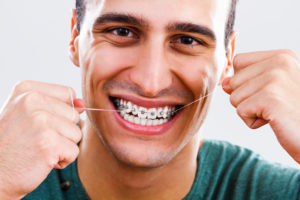
Unless under extenuating circumstances, most dental emergencies are avoidable. Maintaining good oral health and hygiene throughout your time with braces is vital in ensuring healthy teeth and gums, and preventing cavities. Food particles are easier to get stuck between braces, and when not cleaned thoroughly, can lead to other dental emergencies, like tooth decay, which can cause major complications. Hard foods, sticky foods, and foods high in sugar should be avoided as they are known to break brackets and cause cavities, which you more susceptible of developing while wearing braces. Some of the need-to-avoid foods include hard candy, nuts, apples, popcorn, ice, gum, caramel, and licorice.
Because braces are so notorious for getting food stuck in them, make sure that you are brushing after every meal to prevent staining and reducing bacteria buildup in your mouth. Use a soft brush, and brush each tooth by starting at the top and brushing down, then repeating the motion and brushing up around each bracket. Use threadable floss of a floss threader to get the hard to reach areas in between teeth that are covered by the archwire. Using the pointed end, insert between the teeth and gently move the floss back and forth between the two teeth. For added care, use a proxabrush, sometimes called a “Christmas tree brush,” to scrub between each bracket in an up and down motion to get any extra gunk that might be stuck there. For any dental emergencies that you might be having, make sure to contact Belmar Orthodontics at (303) 225-9016 for your next consultation!
Choosing A Good Toothbrush
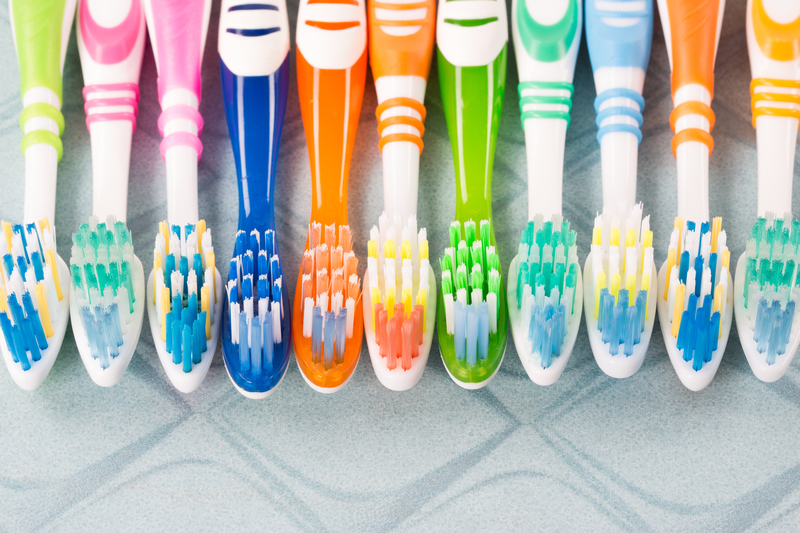
Do you ever look at all the toothbrush options at the store and wonder what the difference is between all of them? Toothbrushes come in all shapes and sizes, and it’s for a reason. They are made to fit certain sizes of mouth. Bristles come in various materials and designs, and there are extra features on some toothbrushes. So what should you choose? Use these tips for the next time you pick out your toothbrush so you know you’re getting a good one for your mouth!
Why So Many Different Kinds?
For something that is so simple to use, there sure are a lot of different toothbrushes out there. Toothbrushes have been around for centuries, with some historians quoting them as being as old as 3000 BC! Ancient civilizations used a “chew stick,” or a twig that had a frayed end in which they would brush their teeth. The common bristled toothbrushes that we are so familiar with didn’t come into existence until around 1498 in China. The bristles that were used in these toothbrushes were actually hog hair that were attached to handles made of bamboo or bone. Even these evolved, though, into the toothbrushes that we use today, but instead with nylon bristles and plastic handles.
Since World War II, oral health has increased in popularity and a variety of different toothbrushes have been invented. But which ones are best? How do you know which toothbrush is for you? Toothbrushes are specifically designed for different sizes and shapes of mouths, plus there are age-specific toothbrushes, like for children, that have smaller (or larger) handles and bristles depending on the age of the person. No matter what toothbrush you use, the principle behind it should be the same: improve your oral health care and prevent disease. Your toothbrush should be helping you do that, if you’re using the right one.
Types of Toothbrushes
There are basically two types of toothbrushes: soft-bristled and hard-bristled. Most dental professionals agree that using a soft-bristled toothbrush is best for cleaning plaque and debris on your teeth. Hard-bristled toothbrushes are not recommended as they are known to wear away your enamel and can lead to gum recession and lesions. Although they do remove more plaque than traditional soft-bristled toothbrushes, hard-bristles cause more damage than good, even when trying to get rid of tough plaque. Toothbrushes with small heads are also great to use because they can get into the hard-to-reach places in your mouth. When deciding between a small-headed or large-headed toothbrush, keep in mind that the size of your mouth should be the determinant for which one you buy. Those people with large mouths should use a full-sized toothbrush head, while those with smaller mouths should utilize a more compact head.
Toothbrushes also vary in the type of the handle (non-slip grip or flexible neck), shape of the head (tapered or rectangular), and style of bristles (rippled, flat, or dome shape). Although there are a variety of kinds, ultimately the best toothbrush is one that fits your mouth and allows you to reach all of your teeth easily. To figure out which one works best for you, trying toothbrushes with different bristle styles or head shapes is recommended until you find one that is most comfortable.
Manual or Electric: Which is Better?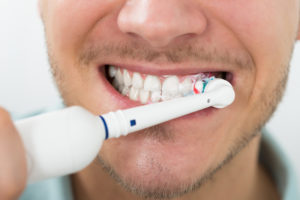
With the advent of the electric toothbrush, many people have been drawn to its ease of use and effectiveness. While manual toothbrushes have been used for centuries, the electric toothbrush is faster and more efficient. If you’re a diligent brusher, manual toothbrushes are a great option, but for those who want the toothbrush to do the work for them, electric is the way to go. Just like manual toothbrushes, electric toothbrushes come in different sizes and have a variety of replaceable heads. Electric toothbrushes are known for having smaller heads than manual, so at the beginning, it may take some time getting used to their small size.
Because of their size, electric toothbrushes are able to clean teeth more thoroughly and get to hard-to-reach areas of the mouth better than manual toothbrushes can. Electric toothbrushes also use different types of bristles movements, such as oscillating/rotating technology, that has been proven to remove more bacteria and plaque than manual toothbrushes. Additionally, electric toothbrushes have a smaller likelihood of hurting your enamel and gums, which is advantageous for those individuals who have sensitive teeth and gums. Whether you choose manual or electric, the most important takeaway is that both fit your mouth size and allow you to clean each individual tooth. If your toothbrush can do both of those things, you’re on your way to achieving great oral health and a nicer smile.
Tips For A Cleaner Mouth
Having the correct toothbrush for your mouth is the first step in maintaining good oral health. But a common question that many have is, “What is the correct way to brush my teeth?” When using a regular soft brush, make sure to angle the brush along the gum line and brush down from the top, then up from the bottom on each tooth in small circles. This motion helps get out the tiny food particles stuck between your teeth, plus it protects your gums from over-brushing. If your gums tend to bleed when brushing, that usually indicates that the gums are inflamed and those areas should actually be brushed more thoroughly and more often. Also make sure that you are brushing your chewing surfaces, the inside of your teeth, and your tongue.
For more tips on how to protect your teeth and maintain a healthier mouth, visit your local provider at Belmar Orthodontics. Change your oral health for the better by calling (303) 225-9016 and setting up your first consult for the comfort, care, and personalized treatment that you deserve!
Braces With Oral Health Problems
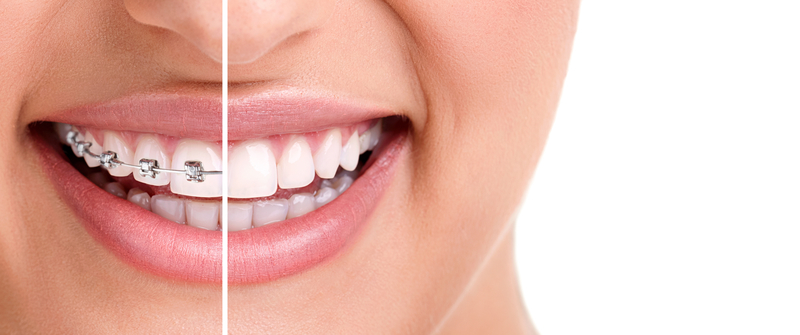
Did you know that your oral health can affect your overall health? Poor oral health can even worsen health conditions you already have such as diabetes or cardiovascular disease. That is because oral health and overall health are highly connected. Your oral issues can become better with braces, but that is only if certain oral health problems are corrected beforehand. Patients can also develop oral health problems if they don’t have the right knowledge with proper braces care. Use these tips to avoid oral health problems with braces and find out how we work around current problems to provide you with a straighter smile!
Oral Health Goals
Did you know that orthodontic treatment can give you a healthier mouth? We know that braces help straighten your teeth, but they can also improve the health of your gums and teeth. When you have crooked and crowded teeth, this makes cleaning your mouth more difficult. This can cause serious oral health problems, such as tooth decay, periodontal disease, and tooth loss. Whether you have straight or crooked teeth, before you let an orthodontist start working on you, there are some important oral health tips to be following before any work begins:
- Eat a healthy diet that limits sugary beverages and snacks
- See a dentist regularly for prevention and treatment of oral disease
- Brush teeth twice a day with fluoride toothpaste
- Floss daily
- Discuss changing certain lifestyle practices, like smoking and using oral piercings
Types of Braces
Braces are a big commitment, and you want to make sure you’re using the correct ones whenever you get them put on. Each of us is a different size and shape, and are mouths aren’t any different. Because of this, there are various types of braces for different sizes and shapes of mouths for children, teenagers, and adults. The four most common types of braces are: traditional, short-term, clear, and Invisalign/ClearCorrect.
Traditional braces are those that we see on a daily basis: a system of wires and brackets that are bonded to our teeth. This type of braces are the most cost-effective, reliable, and are best suited for severe orthodontic issues. Short-term braces are recommended for those patients who wish to align just their front six teeth-the ones that others see the most. These are used for the shortest amount of time (less teeth to align), but there is no adjustment to your occlusion (bite). So if you have a problem with an under/overbite, short-term braces may not be for you. Clear braces are similar to traditional metal brackets except that they use ceramic brackets that match the color of your teeth. These braces have a high aesthetic appeal for those who don’t want to be seen wearing braces, plus they are highly resistant to staining. Invisalign//ClearCorrect straighten your teeth without the traditional wire brackets, and are completely removable, which makes cleaning your teeth a cinch. This type requires more responsibility for the wearer, but if you’re committed to the strict wearing regimen, you can have a straight smile in as little as 12 months!
Taking Care of Your Braces
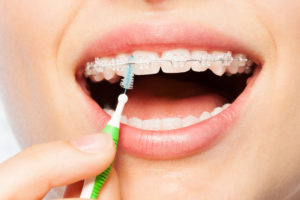
While similar to managing our oral health, maintaining our braces has a few extra steps. To maintain good oral health with braces, it’s important to adopt good oral hygiene throughout the entire process. Brushing after every meal is one of the most important but most overlooked steps in maintaining good oral health. When eating, food particles get stuck in between our teeth and our braces, which can cause staining and bacterial backup between our teeth. Using a regular soft brush in an up-and-down motion on each tooth will do the trick. Secondly, use threadable floss or a floss threader. These tools allow you to get between each tooth and underneath the wires to clean out any food that may be trapped there. Insert the threader between two teeth and move back and forth until the food is released. Lastly, use a proxabrush, or a “Christmas tree brush.” Place the proxabrush between two brackets, below the archwire, and brush up and down. Like the threader, this will also help loosen up any food that may be stuck between your teeth.
A great way to ensure that your braces don’t break and that you don’t get unwanted gunk stuck in them is to watch what foods you’re eating. Foods that are hard, sticky, or high in sugar should be avoided. Eating food that is high in sugar can cause cavities when wearing braces, which can lead to more dental work that you would need to have done. Furthermore, patients with braces should limit between meal snacks and avoid food that could bend the wires, such as caramel, nuts, chewing gum, ice, or popcorn.
When To See An Orthodontist
Now that we understand more about the importance of our oral health, plus the different types of braces, when should we make an appointment with an orthodontist? Many times, we only schedule a time to see an orthodontist whenever our teeth are crooked and we want them straightened. But there are other factors that influence when we should start thinking about getting in to see the doctor:
- Jaws that shift, make sounds, protrude, or are recessed
- Speech difficulty
- Biting the cheek or biting into the roof of the mouth
- Facial imbalance or asymmetry (features out of proportion to the rest of the face)
- Inability to comfortably close lips
- Grinding or clenching of teeth
As mentioned earlier, these are signs that your oral health might not be up to par like it should be. Meeting with your orthodontist and discussing these issues will help them better treat you with one of the four types of braces that we discussed previously. The sooner you get in to see your orthodontist, the sooner any pain or discomfort can be evaluated, treated, and extinguished.
Meet Your New Year’s Resolutions With Our Help!
Belmar Orthodontics can help you on your path towards having a straighter smiles and better oral health. With reputable orthodontists, manageable treatment plans, and services for children and adults, we can help you get the smile that you deserve! Call (303) 225-9016!
Foods and Drinks that Harm Your Teeth
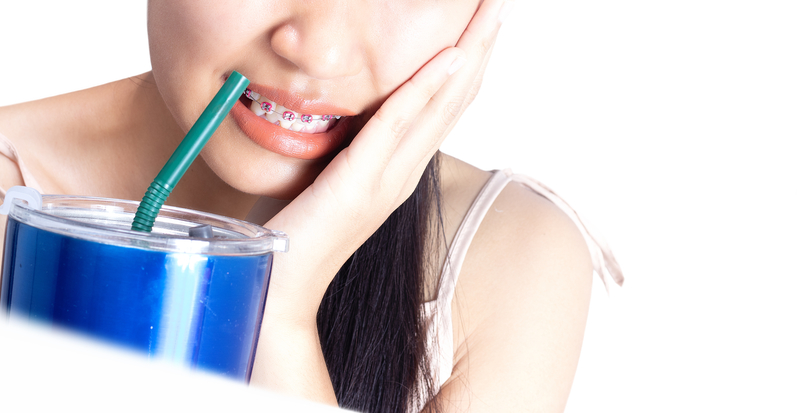
Did you know that what you’re drinking might be hurting your oral health? Many patients experience problems like tooth erosion and thinning without realizing that the problem is what they’re eating. Use this guide to know the effects of foods and drinks on the teeth and what to watch out for!
Wear and Tear on Your Teeth
Your teeth are made of tightly-packed minerals that keep them strong and healthy. Those include calcium, phosphate, magnesium and more. Your saliva helps break down your food and helps to remineralize your teeth each day. Eating certain foods and drinks can strip minerals from your teeth slowly over time, making them weak, sensitive and thinner. These are common oral health problems with age. However, thinning (or enamel erosion) and sensitivity usually come from a lack of oral hygiene. If you enjoy a daily soda or you love your sweet treats throughout the day, you may be weakening your teeth at a rapid pace.

Foods that Cause Damage
Some foods build up your tooth enamel and help it, like dairy products helping to remineralize calcium. Others—like sugar—tear it down. Avoid these foods to keep your smile healthy:
- Anything Citrus: This includes both foods and drinks. Citrus fruits (lemon, lime, orange, etc.) and drinks contain citric acid. This is there naturally or as an additive to maintain flavor. Any type of acid on a label will erode your teeth if you ingest it.
- Sugar: Sugar mixes directly with mouth bacteria to form a sticky film called plaque. That plaque sticks to teeth and causes decay. Because it’s acidic, it will work on your teeth to erode and decay them. The more sugar you eat, the more plaque your mouth makes, and the more erosion and decay you get. This is especially true while wearing braces.
- Hard Candies/Mints: Any candy or mint you suck on (like a sucker) exposes your teeth to sugar constantly, which leads to decay from plaque acid.
- Chewy/Sticky Candy: Any chewy/sticky consistency is destined to get stuck in brackets and wires. It also sticks like glue to the teeth if they’re not brushed properly.
- Starchy Foods: Breads, cookies, crackers, pasta and anything starchy will get stuck in your teeth. All of these quickly break down into sugar, which can affect your teeth and your overall health.
- Popcorn: Popcorn and hard foods like nuts, hard veggies and fruits and non-food items can be bad for your teeth with braces, as they can break your orthodontic appliance. Limit them to avoid orthodontic emergencies.
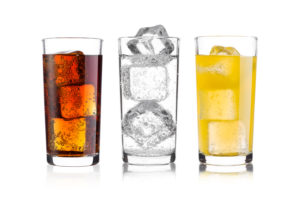
Drinks to Avoid
Drinks can be even more damaging than food in many cases. That’s because you can drink all day long, and if your drink is acidic, those acids stay on your teeth up to 30 minutes. Soft drinks (soda/sports drinks) are notorious for high sugar content. That sugar can create tons of plaque in your mouth that causes decay. As we mentioned, that combination is acidic. Every time you drink, your are making plaque that can weaken your teeth.
Avoid these drinks that are acidic, sugary or can stain:
- Soda: This contains carbonic acid, which comes from a chemical reaction between carbon dioxide and water. It stays acidic on your teeth for up to 30 minutes. Most sodas are incredibly high in sugar, which means they are doubly bad for you.
- Energy drinks, etc.: Energy drinks, sparkling water, and any drink of the sort that contains carbonic acid. Avoid drinks with fizzy bubbles or limit their contact with the teeth by drinking through a straw.
- Sports Drinks: These drinks are often full of sugar, plus citric acid to maintain flavor. Avoid them and stick to water.
- Water Enhancers: Water-flavoring liquids or powders generally contain citric acid to maintain flavor. Even if the substance is clear, the acid will still erode teeth even if the drink isn’t staining them.
- Alcohol: Many contain carbonation (carbonic acid) and all will kill nerves in your mouth, leading to loss of feeling over time.
- Coffee: This drink, tea, wine and anything with blue, purple or red pigments will stain the teeth. If you teeth are eroding over time, the dyes get into small cracks in the teeth, changing tooth color rapidly.
Damaging Habits that Harm Your Teeth
If you want to have your teeth for life, you have to take care of them. You have to try even harder to care for them when you have braces. More than 4 million Americans are wearing braces each year. Some opt for Invisalign aligners, which are removable and which make cleaning the teeth fairly easy. However, many patients—especially children and teens—wear lingual, traditional metal or ceramic braces. All of these types of braces have brackets bonded to the tooth surface and wires that hold them in place.
If you don’t brush and floss like normal, your teeth can decay, erode and you can have problems with both gingivitis or severe gum disease. Your teeth can weaken and break easy and they can fall out. That’s why you want to have meticulous oral hygiene all throughout life. Proper brushing, flossing, visiting the dentist or orthodontist, and using oral health products like mouthwash and fluoride can all help you keep your natural teeth healthy.
With braces, you can have your teeth become thin and weak based on what you eat, or they can decay and change colors based on how you care for them. You can definitely harm your teeth if you’re not cleaning your brackets, wires and teeth several times a day. Good oral hygiene care is vital to having a healthy and beautiful smile at the end of your treatment. An easy step to avoid problems is to avoid the foods and drinks we listed above. Be even more careful about those foods and drinks with braces. For specific questions about certain foods or drinks, or help for proper braces care, call Belmar Orthodontics today at (303) 225-9016!
Avoid These Sweet Treats at Halloween with Braces
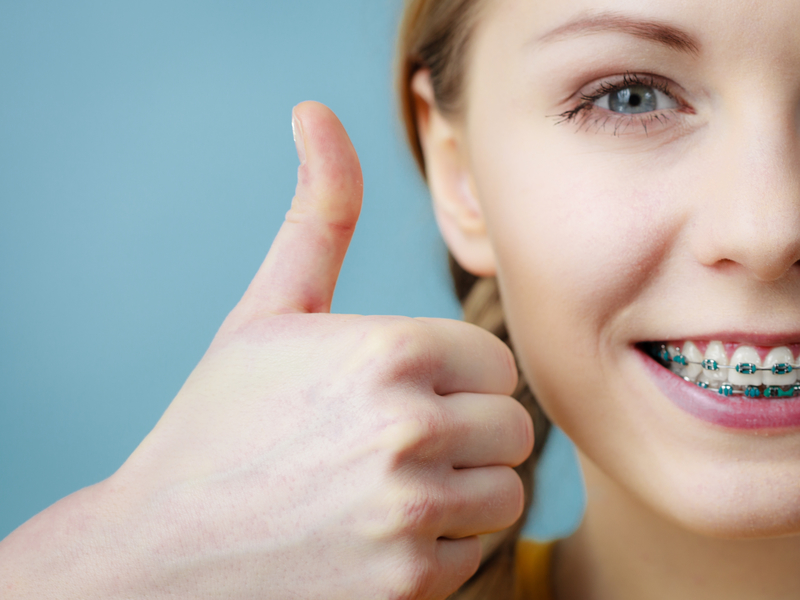
Halloween can be an incredibly fun time for kids and adults alike. However, the not-so-fun part is developing cavities later on because of that Halloween candy. Sugar is directly related to tooth decay, but it’s even worse if you have braces on your teeth. There are specific candies you should try to avoid if you have brackets and wires, as they can get stuck easier. Find out what these are and tips to reduce your risk for tooth decay during the holidays!
How Popular Is Halloween?
About $2.4 billion dollars is spent in Easter candy each year. However, Halloween candy is a close second at around $2.1 billion in sales. Divided up into individual households, that’s about $44-$47 dollars spent on Halloween candy in each household.
If you think Halloween candy sales are scary, here are the facts on the actual candy consumed on Halloween day itself:
- Almost all children and at least ½ of all adults eat candy on Halloween day.
- However, the amount of candy consumed is well-past the recommended 6 or less teaspoons children should have in a day. Adults should only have between 6 and 9 teaspoons of sugar (tops) per day. On Halloween itself, up to 3 cups of candy is consumed per child.
- That equates to about 48 teaspoons of sugar per cup, or about 144 teaspoons of sugar, or 675 grams of sugar in one day.
- USA Today reports that 4% of all the candy eaten in the U.S. is eaten on Halloween day.
- Reader’s Digest reports that the amount of calories children and adults alike eat on Halloween equals anywhere between 3,000 and 7,000 calories.
- Not only can this much sugar lead to incredible health problems and diabetes, but sugar—the main ingredient in that candy—is the direct cause of tooth decay.

How Can Candy Hurt Your Teeth?
Candy is damaging to your teeth because of the sugar, which is a direct factor in your risk for tooth decay. The more sugar you eat, the more cavities you could get. When you eat or drink, sugars in food will mix with certain bacterias in your mouth. That mixture will create a sticky substance called plaque. You can’t simply swallow that plaque either. It sticks to your teeth and becomes an acidic substance when it mixes.
Because it’s acidic, as it sticks to your tooth enamel like a film, it will work to erode and decay your teeth. It does this by breaking up the minerals that make up your tooth enamel layer. If you don’t brush and floss your teeth often enough, or you eat a ton of sugar, you have plaque working hard on your teeth to destroy them.
Plaque can decay your tooth surface to create surface cavities. If enough decay happens on that layer, it can get through to the inner layers of the teeth, causing internal (and sometimes large) cavities that can turn into infections and tooth loss. Sugar is the main food for plaque, which is why candy—whose main ingredient is sugar—can hurt your teeth.
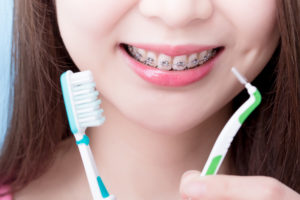
Avoiding Specific Sweet Treats with Braces
Anyone can get cavities and other oral health problems from a large candy or sugar consumption. You don’t only have to worry about candy either when it comes to cavities—you have to worry about all foods. Most foods you can buy at the store have added sugars in them. That includes juices, sports drinks, and sodas, as well as the obvious sugar foods like candy, cakes, ice cream and cookies. Always check food labels to see how much sugar a food contains.
There are specific foods you want to avoid if you wear braces, as those foods and candies can make it much easier for you to get cavities. Especially at Halloween, popular candies are ones that are chewy and sticky. Anything chewy and sticky will get stuck in your brackets and wires if you wear lingual, ceramic or metal braces. Sweet treats you want to avoid if you wear braces include:
- Gum: Gum is made to be elastic and sticky and can stick to brackets like crazy. Avoid it completely with braces. After your braces are off, chew sugar-free gum.
- Chewy/Sticky Candy: Examples include caramels, taffy, Tootsie Rolls, Starburst, licorice, Skittles, Sugar Daddies and any candies that are similar. Avoid fruit snacks, gummies and dried fruit as well, which are all incredibly sticky.
- Hard Candies: These go hand-in-hand with suckers and mints. All of these candies expose your teeth to sugars for prolonged periods of time, which means a prolonged risk for acidic plaque and tooth decay.
- Sodas/Citrus Drinks: These and any carbonated drinks all contain either citric acid or carbonic acid, which erode the teeth. That can mean you have tooth erosion and decay all around your brackets, which will be very noticeable when your braces come off.
Enjoy Some Sweetness This Halloween
When it comes to Halloween, we want all of our patients to have fun and to enjoy the holiday. Candy is naturally a part of that holiday, but it doesn’t mean that you have to experience tooth decay in the weeks following it. Every person needs to be conscious of their candy consumption on Halloween to avoid tooth decay, erosion and health problems in general.
You don’t want to work hard for 18-24 months getting a straight smile if it’s decayed when your braces finally come off. Enjoy your Halloween sweet treats, but be mindful of your oral health. Brush your teeth 3 times a day or after every meal with fluoride toothpaste. Floss your teeth at least 1-2 times a day. Avoid sticky and sugary treats and clean the teeth very well if you do eat them at Halloween. Avoid acidic drinks and watch your sugar consumption. For tips on cleaning your teeth correctly with braces to avoid tooth decay, call Belmar Orthodontics today at (303) 225-9016!
Dental Services You Need During Braces
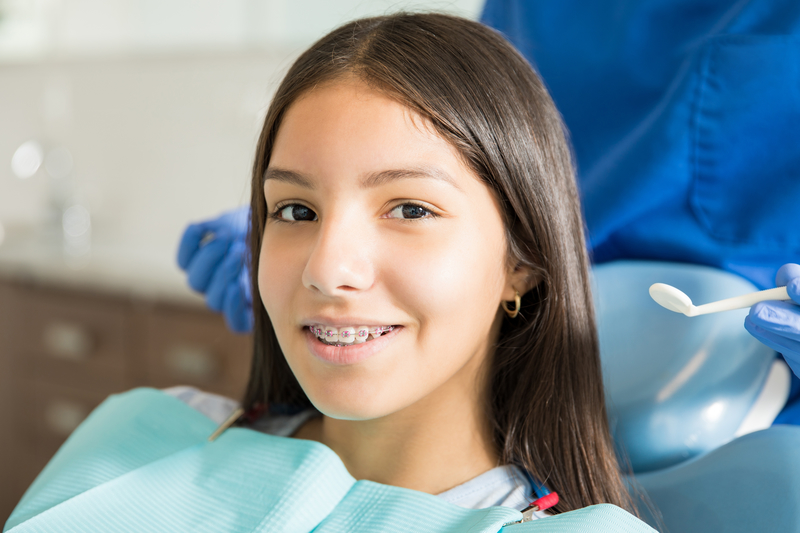
Getting braces through an orthodontist does not mean you should stop seeing a dentist for dental services. In fact, you may even need to get dental services more often with braces. This is because brackets and wires inevitably raise your risk for getting food and plaque stuck in your teeth. Those substances can then lead to quicker tooth decay, gum problems and tooth erosion. Find out what you can expect from your orthodontic visits and why you should keep scheduling in dental services during your treatment.
How Do Braces Change Your Teeth?
Not everyone will get braces during their lifetime. However, for those that do, they can change a smile in incredible ways. You may see children wearing braces from time to time. This is just so they can get a great smile, but that is part of it. Children should see the orthodontist around age 7 or 8 to determine if bite or alignment issues are present. If so, a child could grow up with speech impediments, problems with tooth decay and gum disease, and difficulty chewing, eating and biting. With interceptive orthodontics—or child orthodontics—we can correct those problems so a child develops properly.
With adults and teens, straightening treatment generally starts around age 11 or 12 and older. This is when most (if not all) of the adult teeth have come into the mouth. However, it’s common for the adult teeth to come in crooked, which can make people self-conscious about their smiles. When patients decide to get braces to straighten their teeth, studies show that confidence grows and people show their smiles more. That confidence can lead to more success in the future, motivation to do more and be more, and better oral health.
Straightening the teeth makes the teeth easier to clean. This is because crooked teeth can create areas in the mouth where the teeth are incredibly hard to clean. If you can’t brush nooks and crannies well or if you can’t pass floss through the teeth, those areas are likely to decay. Teeth that are crooked or at different angles also have different amounts of pressure placed on them, which can cause the teeth to crack or break under pressure. That is why straightening the teeth can help prevent not only dental emergencies, but also problems like tooth decay and gum disease.
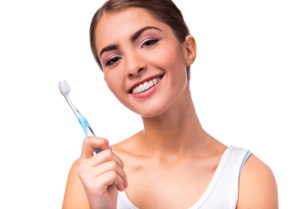
Changes You Want to Avoid
With your dental health, you always want to invest in dental services like dental cleanings, comprehensive exams and your own at-home cleaning. If not, you can start to develop problems with cavities and gum disease. Both of these conditions (as well as bad breath, oral sores and more) stem from poor oral hygiene. When you eat, bacteria in the mouth mix with sugars in your food to create a sticky film called plaque. That film is acidic and it sticks to your teeth instead of being swallowed. The acid erodes the layers of your teeth, decaying them to create cavities. This is how they form, and they can happen much easier with braces.
Three types of braces you can choose (traditional, lingual, ceramic) will require brackets and wires attached to your teeth. The brackets are bonded to the center of your teeth, with a wire that runs through them. Your brackets are areas where plaque and food can easily get stuck. If they become stuck or particles build up around your brackets, this can create areas of decay rather quickly. Many people also don’t floss like they should with braces because it takes just a bit longer. However, when food sticks around and you skip flossing, you are leaving about 40% of your tooth surfaces open to decay. That means, when you get your braces off, you’ll be left with areas of tooth erosion (or craters) and cavities.
You also want to avoid foods with dyes in them, including drinks. When you drink or eat something with dyes (like blueberries, strawberries, blackberries and drinks died those colors), then your tooth color can change over time. This could mean that you have small squares on all of your teeth at the end of treatment that are a different color than the rest of your teeth. Soda, juices and carbonated drinks can all do this as well, except that they will also wear away parts of your teeth.
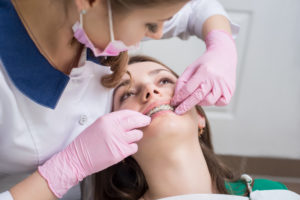
Continue Dental Services During Braces
All of those changes to your teeth can be avoided if you keep up on your personal hygiene at home and dental services in-office. This means, you should:
- Brush your teeth every single day, after every single meal, for two minutes each time you brush. Practice brushing at 45-degree angles to dislodge food from brackets and cover all the tooth surfaces. Use a proxabrush to dislodge stuck food even easier.
- Floss each day, at least 1-2 times. Use a floss threader or threadable floss to make this easy for you.
- Use a waterpik tool if you tend to get food stuck in specific places.
- Keep up on your braces adjustments and your orthodontic appointments.
- For dental services, make sure you visit the dentist at least twice a year for comprehensive exams and dental cleanings.
We want to focus on that last one. Dental cleanings and comprehensive exams are so important for the health of your mouth. With dental cleanings, the hygienists can do thorough cleanings on your teeth and brackets and spot the signs of erosion, decay and color changes. Those professionals can spot the signs of decay and gum issues. If needed, we can work with them to remove certain brackets where dental work is needed. Orthodontists and dentists are not the same even though they have had the same schooling. Make sure you are visiting both during your time with braces. If you want to avoid problems with cleaning brackets and wires, ask us about our Invisalign treatment option. You can do this by calling Belmar Orthodontics at (303) 225-9016!
Prevent Tooth Enamel Problems During Braces with Proper Orthodontic Care
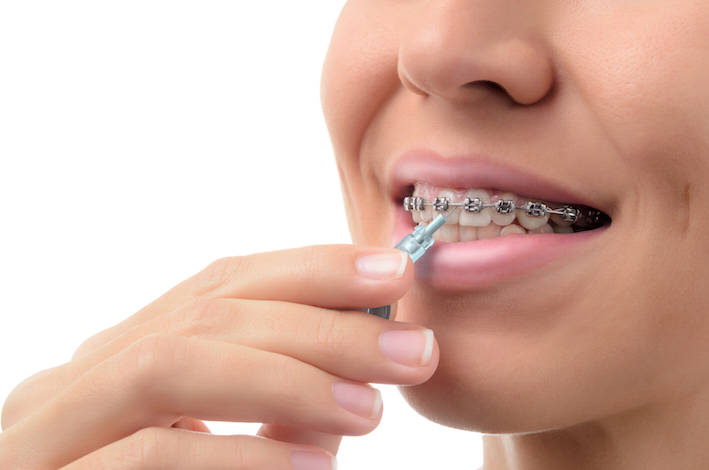
There are many oral health problems that can happen with braces if you are not focused on your orthodontic care and brushing/flossing of your teeth. Your diet can damage your teeth during your orthodontic treatment, which is why we want you to avoid certain foods and drinks. Your diet can damage your teeth during your orthodontic treatment, which is why we want you to avoid certain foods and drinks. Overly acidic or sugary foods and drinks can lead to tooth decay and acid erosion that harms your tooth enamel. We can help you to know what foods and drinks to avoid so you don’t have dental problems during your time with braces!
Increased Risk of Tooth Decay When With Braces
Braces provide patients with a spectacular tool for straightening smiles and correcting jaw problems that impact self confidence and overall oral wellness. Technology has improved over the years allow for less and less of an apparatus on the tooth enamel, but, nonetheless, there is still an apparatus sitting on your teeth for the duration of your treatment. Unless you are wearing removable Invisalign aligners for your orthodontic treatment, your apparatus will consist of wires and brackets. Your wires and brackets are fundamental to the treatment process, but they also can make it difficult to remove food particles that get stuck under, between and in your brackets and wires. If this food is left to fester, the acidic content of the food can eat away at your tooth’s vital tooth enamel.
Combat this type of tooth decay by using the tools your orthodontist recommends for cleaning your teeth. This includes regular brushing, an interdental brush, floss (and floss threaders) and possibly a water flosser to help you use the force of water to rid your mouth of stuck debris.
Acidic Foods and Drinks Erode Tooth Enamel
When it comes to taking care of your teeth with braces, one of the best things you can do is pay attention to what you are putting in your mouth. Thinking about what is coming in contact with your pearly whites can protect your teeth from erosion and decay.
Certain foods and beverages are more acidic (eroding) than others. Low acid foods are better for your teeth even though some of their high acidic counterparts are good for your body. During orthodontic treatment, focus on eating foods that are BOTH good for your body AND your teeth.
Less tooth-friendly foods and drinks include: apples, cherries, oranges, peaches, pears, plums, pineapples, raspberries, tomatoes, pickles, soft drinks, fruit drinks, vinaigrette dressings, BBQ sauces and salsas.
More tooth-friendly foods and drinks include: bananas, mangoes, melons, carrots, cucumbers, lettuce, beets, milk, water, meat, poultry, seafood, eggs, crackers, soups and pasta.
Orthodontic Care: Cleaning Teeth at Home
If ever there was a time to skimp on your oral hygiene it is NOT when you have braces. Diligent home care can make a significant difference in your smile results post-orthodontic treatment. Here are three steps to follow to help you find success:
- Brush after every meal. Because your braces can easily attract and trap food particles, brushing after each meal can help prevent staining and reduce the potential for bacteria buildup. To brush teeth with a regular soft brush, brush down from the top, then up from the bottom on each tooth with a bracket.
- Use a threadable floss or a floss threader. (If using a floss threader, thread regular floss through the eye of the threader, the same way you would with a sewing needle and thread.) Using the small or the pointed end, insert the floss or floss threader between the teeth, but below the archwire. Gently move it back and forth until it is able to thread the floss between the teeth. Once in place, you can floss the two teeth on either side of where you have inserted the floss, taking care not to apply force or pressure against the archwire. Repeat between all teeth.
- Use a proxabrush (interdental brush). After brushing with a toothbrush, use a proxabrush, commonly referred to as a “Christmas tree brush,” to clean between each bracket. Place the proxabrush between two brackets, below the archwire, brushing up and down. After several strokes, repeat this motion by inserting the brush from the opposite side (either down from the top or up from the bottom).
If you are having ANY difficulties cleaning your teeth with these above tools, contact our office so we can help!
Schedule an Orthodontic Care Consultation to Protect Your Tooth Enamel
Your time with braces will come and go in a flash, although you might not believe that in the beginning. The efforts you make from day one with your braces to protect your tooth enamel will show in the results of sparkling, white, strong, healthy teeth. Our friendly staff at Belmar Orthodontics is available to train you in methods and tools for keeping your teeth clean and strong. Make sure to keep your regular cleaning and check-up appointments so we can examine your teeth and make suggestions for improvements. Make an appointment by contacting our office today at 303.225.9016. We are excited to meet you and help you reach your smile goals!
Cavity Treatment During Braces
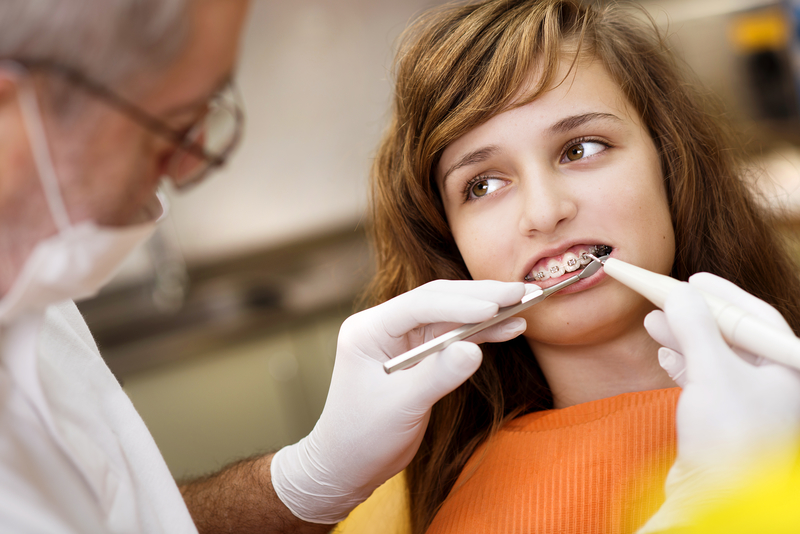
Did you know that an orthodontist and a dentist are not the same? Only a dentist can help with cavities, gum disease and more, while only an orthodontist can straighten your teeth in a certain way. A patient’s time with braces is a time when cavities happen very quickly, because the teeth are harder to clean. To prevent cavities during your time with braces, it is vital that you continue to see a dentist. If you do happen to get a cavity, find out what that cavity treatment will look like!
Proper Oral Hygiene
The American Dental Association recommends that every patient brush their teeth at least twice a day to avoid tooth decay. Brushing after every meal is even better for avoiding plaque buildup that leads to decay. Every patient should also floss their teeth at least once a day. Using fluoride toothpaste is best, because fluoride helps coat the teeth in a protective layer that prevents decay and keeps tooth enamel stronger. Patients can also benefit from mouthwash, as it can kill bacteria that would otherwise create plaque.
However, these recommendations are for people that don’t have braces. Every single person—children, teens and adults—should follow these recommendations. Infants should not use fluoride or mouthwash, but their child toothpastes generally have safe amounts of fluoride in them. If you are a patient that is receiving orthodontic care via braces, you have to go the extra mile with your oral hygiene. That means more frequent brushing, more flossing and watching what you eat.
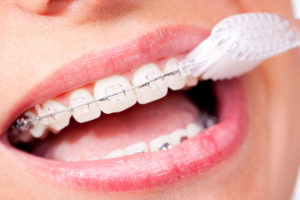
Taking Care of Braces
Braces can be tricky to clean. However, their design provides the best and quickest way for you to straighten your teeth, which is why traditional metal braces have been around for so many decades. Metal braces, ceramic braces and lingual braces all have a brackets-and-wires design.
However, with braces, you must be meticulous with cleaning them or you will have food and plaque get stuck places. If you don’t unstick those substances, they will quickly erode your tooth enamel and cause decay around your appliances. This can happen on every tooth as well.
Follow these tips for cleaning your braces:
- Brush after every single meal. This reduces staining and bacteria buildup. Use a regular soft-bristled brush and brush down from the top, then up from the bottom. Brush in all different directions to dislodge food.
- Use a threadable floss or a floss threader. Both will require that you thread the floss through each space between your teeth. You will have to go under the wire to do this, and it will take slightly longer than normal flossing. This is one of the most important oral hygiene recommendations to follow!
- Use helpful tools. A proxabrush is a small braces brush that can help unstick foods. It looks like a tiny Christmas Tree brush. A waterpik is also helpful. This is a tool that helps blast away food particles with a stream of water.
Tooth Decay with Braces
Many children and teens skip flossing or brushing here and there. Every time you skip on an oral hygiene habit, it increases your risk for tooth decay—or cavities—with braces. Your time with braces is one where you have to be super careful about your oral health. Most people picture their beautiful smile after getting their braces off, but they don’t think about cavities and tooth erosion. You can end up with tooth decay and parts of your teeth that have eroded due to your oral hygiene habits with braces.
Nobody wants to spend 18-24 months perfecting their teeth only to be disappointed in their smile. That’s why oral hygiene is so important. Tooth decay happens rapidly, and it can happen where the brackets are bonded to your teeth and in-between your teeth because it is harder to floss. Normally, you would simply visit the dentist and have your cavity removed and filled. However, cavity treatment is a bit different with braces.
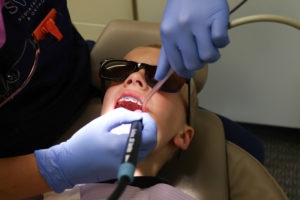
Cavity Treatment with Braces
Cavity treatment is slightly harder if you have braces, but not impossible. Generally, decay happens between teeth cracks and around brackets and wires. If you have tooth decay that is in a tricky spot, we can remove your wire so that a dentist can provide you with a proper cavity treatment. You will have to have your appointments scheduled close together (dentist and orthodontist) so that you can get your cavity filled and your wire replaced.
In severe cases of tooth decay, we may have to remove a bracket from the tooth if it interferes with the dental work that needs to be done. We only do this in certain cases, and we replace the missing part as soon as possible so your teeth don’t move. Cavity treatment—with taking out the tooth decay and filling it—is the same with braces as it is without, only you have to work around orthodontic appliances if you have braces. Always let us know if you have tooth sensitivity, sharp (and even mild) pain when chewing and if you have sensitivity to hot or cold foods. This signals that there may be a more severe cavity.
Prevent Cavity Treatment
The goal of every patient—old and young—is to avoid tooth decay altogether. If you do, you’ll never have to worry about cavity treatment with braces. If your decay is small and in a tricky spot, you may have to wait until your braces are off to receive your cavity treatment. That might make your cavity grow larger, which is something you don’t want. Always see the dentist to check your mouth for tooth decay before you receive orthodontic treatment. This can avoid many problems in the future.
If you are prone to getting cavities or you have weak enamel, consider receiving Invisalign treatment instead of getting brackets and wires. This will help you avoid problems with cavities and needing to get cavity treatment. If you have tooth pain or want to learn more about cavity treatment with braces, call Belmar Orthodontics today at (303) 225-9016!
Oral Health Facts for Children and Adults

Did you know that what you eat makes a major difference in how healthy your mouth is? What you eat can determine your likelihood for tooth decay and other oral health diseases. Did you know that your teeth also aren’t bones like many people think? They are made of an entirely different substance even though they are hard like bones. Find out oral health myths and facts that exist, how to care for your teeth properly, and some facts about orthodontic care!
Are Your Teeth Bones?
Many people think the teeth are bones, but they aren’t. They are hard like bone, but are actually harder. Teeth are the hardest substance in your body, as they are made up of about 96% mineral. Bones have a more sponge-like interior and aren’t solid mineral. However, your teeth and bones are made of similar materials such as calcium and phosphate, which is why they are both so hard.
Facts About Your Teeth
Infant and adult teeth are not the same:
- Infants are not born with their teeth. Most start to get teeth between 3 and 9 months of age.
- Children can receive their teeth up until age 3. Some will get all their teeth within a few months, whereas others get them slowly one-by-one.
- Children only have 20 baby teeth compared to an adult’s 32.
- As soon as a child gets a first tooth, it needs to be brushed at least twice a day. Infants also need to see the dentist within 6 months of getting their first tooth.
- Bite and alignment problems in children are best treated around ages 7 and 8. This is the recommended time for children to visit an orthodontist. If bite and alignment problems are present, child braces can correct the problems before they become severe later on.
- Children get their teeth in a certain order: the bottom front 2 teeth, followed by the top 2 teeth. Then, the next tooth on either side on the bottom jaw, then the next two on either side on the top jaw, etc.
- Children lose their teeth in the order that they came into the mouth. Losing the baby teeth makes way for the adult teeth to start coming in once a child has grown larger.
- Adults will have 32 total teeth. Most will have the 4 wisdom teeth taken out, which drops that total number down to 28.

Brushing and Flossing
Many people brush their teeth but don’t see the importance of flossing. Plaque doesn’t go away unless you physically remove it with brushing and flossing. Only brushing your teeth is like only cleaning the outside of a car and never the inside. The inside parts can fill up with gunk, just like the spaces between your teeth. Flossing is especially important during your time with braces. Not flossing could land you with cavities or cratered parts of your teeth when braces come off.
Avoiding the Dentist or Orthodontist
“The dentist/orthodontist is scary”. Although many think the dentist is scary, it’s not actually. Some people fear going to the dentist, even though the dentist is someone who is only interested in helping you be healthier. Going to the actual dental office can evoke negative feelings if you’ve had a bad experience. This is why sedation dentistry was created. This is a form of dentistry where you can receive sedation during your procedure to help make it a more positive experience. If you think the dentist (or the orthodontist) is scary, we can help it be less scary. That’s especially because an orthodontist won’t have needles and drills at your appointment. They either put your braces on or tighten them for you. Not so scary, right?
Myths About Orthodontic Care
There are many myths about orthodontic care that could hurt you if you’re not careful. You want to always seek out the best care for your teeth and receive that care from a trained professional.
- Providers who offer orthodontic treatment are orthodontists: false. Now, more than ever, there are many dentists or oral health professionals that are starting to offer orthodontic treatment. Many offer this treatment in the form of Invisalign aligners. This is a great system for straightening the teeth, but only if you have the right training. Orthodontists are specifically trained to straighten your teeth correctly. Dentists are not unless they have specifically received schooling and training in orthodontics. Check credentials before you let someone touch your teeth.
- Braces are too expensive: false. Braces aren’t the cheapest purchase in the world, but they can benefit you more than most other things you’ll ever invest in. Many insurance plans work with patients to make braces affordable, and we do the same. We want as many people as possible to receive orthodontic care. If you think they are too expensive, give our office a call and we will work with your budget. Any person can receive great orthodontic treatment if they work closely with an orthodontist.
- Braces are only for children: false. Studies show that at least ¼ of people that wear braces (so about 1 million+ each year) are adults. Almost half of the people wearing braces are teens. So no, braces are not just for children. Adults also have several virtually-invisible options for orthodontic care such as transparent aligners and lingual braces. These options make braces a great choice for adults.

Great Oral Health
No matter the myths or facts you’ve heard about your oral health, the bottom line is that it’s important! How well you take care of your teeth will determine how good your health is and how much confidence you have in yourself. Studies show that people with straighter, more beautiful smiles are happier, healthier and more confident. You can have that confidence to no matter if you are young or old. To learn more about braces and proper oral hygiene while having them, call Belmar Orthodontics today at (303) 223-9016!

